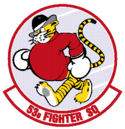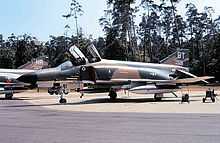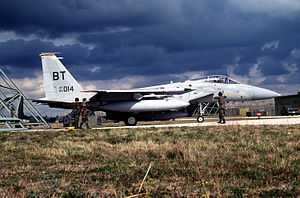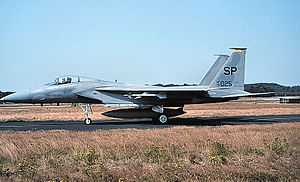53d Fighter Squadron
| 53d Fighter Squadron | |
|---|---|
|
53d Fighter Squadron F-15C Eagle 79-0025 showing "SP" Tail Code, Spangdahlem AB, Germany, 1995 | |
| Active | 1 January 1941-31 March 1999 |
| Country |
|
| Branch |
|
| Type | Squadron |
| Role | Fighter |
| Decorations |
Belgium Fourragère |
| Insignia | |
| 53d Fighter Squadron emblem |
 |
The 53d Fighter Squadron is an inactive United States Air Force unit. It was last assigned to the 52d Operations Group and stationed at Spangdahlem Air Base, Germany. It was inactivated on 31 March 1999.
History
World War II
Caribbean Defense
Activated on 1 January 1941 as one of the three squadrons assigned to the 32d Pursuit Group as part of the United States buildup of forces after the eruption of World War II. This unit was organized for the most part, from Puerto Rico based units, as were many of the aircraft. It was equipped with a mixture of Curtiss P-40 Warhawks, along with Curtiss P-36A Hawk, Northrop A-17s and at least one Vultee YA-19. After being formed at Albrook Field, Panama Canal Zone, the squadron was moved to Rio Hato Army Air Base, Panama. The unit moved to La Chorrera Field on 7 January 1942 after briefly being assigned to France Field on 30 December 1941.
Along with other Pursuit Squadrons, the 53d was re-designated as the 53d Fighter Squadron on 15 May 1942. During late 1942, three Douglas P-70 night fighters were briefly assigned to the 53d as, during this period, it was still considered a strong possibility that a night attack on the Panama Canal might he attempted, and the night fighter defenses of the area were nil. The P-70's departed in mid-January 1943.
Like a number of other Sixth Air Force fighter units, the 53d effectively assumed the duties and designation of the 30th Fighter Squadron on 3 January 1943. The 30th was at La Chorrcra and the 53d at France Field at the time this "switch" took place. By April–May 1943, the unit was operating with an assortment of aircraft as a result of its "switch" with the 30th FS, which by then included Bell P-39D Aircobras and P-40s.
The unit was reassigned to the United States effective 1 June 1943, ending its duty with Sixth Air Force.
European Theater of Operations
Transferred to III Fighter Command in June 1943, began training for deployment to the European Theater of Operations (ETO) as a P-47 Thunderbolt fighter-bomber squadron. Deployed to England in April 1944 as part of IX Fighter Command. Initial missions included strafing and dive-bombing armored vehicles, trains, bridges, buildings, factories, troop concentrations, gun emplacements, airfields, and other targets in preparation for the invasion of Normandy. The squadron also flew some escort missions with Eighth Air Force Boeing B-17 Flying Fortress and Consolidated B-24 Liberator strategic bombers.
On D-Day the squadron patrolled the air over the landing zones and by flying close-support and interdiction missions. Moved to its Advanced Landing Ground at Brucheville, France (A-16) in July, then eastward as ground forces advanced on the continent. Operations supported the breakthrough at Saint-Lô in July and the thrust of U.S. Third Army toward Germany in August and September as part of the 303d Fighter Wing, XIX Tactical Air Command. In October, the squadron moved into Belgium to support U.S. Ninth Army.
Participated in the Battle of the Bulge during December 1944 and January 1945 by flying armed reconnaissance and close-support missions. Aided U.S. First Army's push across the Roer River in February 1945. Supported operations at the Remagen bridgehead and during the airborne assault across the Rhine in March.
By V-E Day, the squadron was based at Kassel/Rothwesten airfield, Germany (ALG R-12), where it remained until February 1946 as part of the United States Air Forces in Europe Army of Occupation. In February, the unit was transferred, without personnel or equipment to Bolling Field, Washington, D.C where it was inactivated as a paper unit.
United States Air Force

Re-activated in October 1946 under Caribbean Air Command in the Canal Zone, returning to its prewar mission of the defense of the Panama Canal. The squadron conducted air defense training missions for the next two years initially with P-47's. The squadron upgraded to jet aircraft in December 1947 with the arrival of the Lockheed F-80 Shooting Star.
As a result of the Berlin Blockade and other Cold War tensions in Europe, the squadron was deployed to West Germany and was reassigned to the United States Air Forces in Europe during August 1948, becoming part of the third F-80 jet group assigned to USAFE. At Fürstenfeldbruck AB tactical operations included air defense, tactical exercises, maneuvers, and photographic reconnaissance. Upgraded to new F-84E Thunderjets in 1950.

Remained at Fürstenfeldbruck until 1952 when it was reassigned to the new Bitburg Air Base, west of the Rhine River near the French border in the Eifel mountains. In August 1953, the North American F-86F Sabre was introduced to the squadron, replacing the F-84s. In 1956, the squadron received the North American F-100 Super Sabre, marking the first time a wing in USAFE flew supersonic jets. On 15 May 1958, the squadron was redesignated as a Tactical Fighter Squadron because its missions had now grown to include delivery of tactical nuclear weapons.
In May 1961, received the Republic F-105 Thunderchief and continued to carry on its Cold War mission of tactical nuclear weapons delivery. Twice in the early 1960s when Cold War tensions were elevated due to the 1961 Berlin Wall crisis and 1962 Cuban Missile Crisis the squadron rose to a high level of alert. Was upgraded to the F-4 Phantom II in 1966.

The squadron was upgraded to the McDonnell Douglas F-15A Eagle in April 1976 In 1980 more advanced F-15Cs and F-15Ds would replace the original F-15As. Throughout the 1970s and 1980s, the squadron conducted routine training missions however the outbreak of the 1990–91 Gulf War put the F-15s of Bitburg into the heart of the conflict. The squadron's pilots and aircraft engaged in combat operations during Operation Desert Storm. Not a single F-15 aircraft was lost in combat during the war. On 13 March 1991, the deployed squadron returned to Bitburg AB.
Bitburg Air Base was part of the 1993 Base Realignment and Closure (or BRAC) process that saw the drawdown of many military facilities in a series of post-Cold War force reductions. In July 1993, HQ USAFE announced the closure of Bitburg Air Base and the pending inactivation of the 36th Fighter Wing.
The 53d Fighter Squadron was relieved from assignment to the 36th Operations Group on 1 February 1994. It was in non-operations status until it was assigned to the 52d Operations Group (52d FW) at Spangdahlem Air Base on 25 Feb 1994. At Spangdahlem the squadron supported no-fly zone operations over Bosnia and northern Iraq and other combat operations. It was during the squadron's support of the no-fly zone in northern Iraq that two of its fighters were involved in the 1994 Black Hawk shootdown incident.
Inactivated in March 1999 as a result of an Air Force-wide reorganization to enlarge F-15 squadrons from 18 to 24 aircraft, and Eagles were reassigned to other squadrons.
Lineage
- Constituted 53d Pursuit Squadron (Fighter) on 22 Nov 1940
- Activated on 1 Jan 1941
- Re-designated: 53d Fighter Squadron, (Twin Engine) on 15 May 1942
- Re-designated: 53d Fighter Squadron on 28 Sep 1942
- Re-designated: 53d Fighter Squadron, Single Engine, on 20 Aug 1943
- Inactivated on 31 Mar 1946
- Activated on 15 Oct 1946
- Re-designated: 53d Fighter Squadron, Jet Propelled, on 27 Oct 1947
- Re-designated: 53d Fighter Squadron, Jet, on 17 Jun 1948
- Re-designated: 53d Fighter-Bomber Squadron on 20 Jan 1950
- Re-designated: 53d Fighter-Day Squadron on 9 Aug 1954
- Re-designated: 53d Tactical Fighter Squadron on 8 Jul 1958
- Re-designated: 53d Fighter Squadron on 1 Oct 1991.
- Inactivated on 31 March 1999
Assignments
- 32d Pursuit (later, 32d Fighter) Group, 1 Jan 1941
- 36th Fighter Group, 23 Jun 1943 – 31 Mar 1946
- 36th Fighter (later, 36th Fighter-Bomber; 36th Fighter-Day) Group, 15 Oct 1946
- Attached to 36th Fighter-Day Wing, 1 Oct 1956 – 7 Dec 1957
- Attached to: Tactical Fighter Wing Provisional, 4, 20 Dec 1990 – 20 Mar 1991
- Attached to: Tactical Fighter Wing Provisional, 4404, 20 Mar 1991 – 1 Jul 1991
- 36th Operations Group, 31 Mar 1992 – 1 Feb 1994
- 52d Operations Group, 25 Feb 1994 – 31 March 1999
Stations
|
|
Aircraft
|
|
References
![]() This article incorporates public domain material from websites or documents of the Air Force Historical Research Agency.
This article incorporates public domain material from websites or documents of the Air Force Historical Research Agency.
- Ravenstein, Charles A. (1984). Air Force Combat Wings Lineage and Honors Histories 1947–1977. Maxwell AFB, Alabama: Office of Air Force History. ISBN 0-912799-12-9.
- USAF 53d Fighter Squadron History
